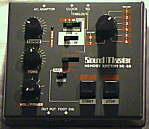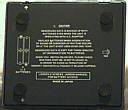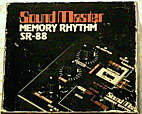SoundMaster
- Memory Rhythm SR-88 (simple analogue drum
computer)
This is one of the very first digitally programmable drum computers.
It has only 4 analogue sounds and can store only 6 patterns with 16 steps
and 2 patterns with 12 steps. Programming works by selecting the sound
by a switch and then pressing 12 or 16 times the "play" or "pause" button.
This is very uncomfortable but may be interesting for making experimental
patterns for tekkno. There are no presets but only some default patterns
shown in the manual, but even these need to be re- entered by hand after
removing batteries.
main features:
-
6 memories for 16 step patterns, 2 memories for 12 step patterns
-
variations A, B, AB per pattern and fill-in 4, 8, 16
-
tempo, tone and volume control pots
-
programming by selecting a sound and then stepwise pressing play/ pause
buttons (awkward)
-
sound generator with only 4 analogue sounds (base, snare, hihat, cymbal)
using transistor noise. The base drum has a mild drone and everything sounds
quite 1970th home organ- like. Interesting is that the transistor noise
based sounds become the more metallic and whistling the more volume is
turned up.
-
4 bit micro- controller CPU (That's why only 4 sounds exist?!)
-
external clock trigger and foot switch input
-
need batteries to store data, even when operated by external power supply.
This means that always batteries need to stay in it to keep data and thus
need to be checked all few months to prevent corrosion damage from leaking.
-
auto- power- off when output cable is plugged out
notes:
When I bought mine on flea market, it didn't work because the battery holder
was cracked and a small diode was burnt out. After replacing it the thing
worked again. The case is quite awkward to dismantle because there are
lots of potentiometers screwed to the front cover, those hang on short
cables to the PCB. 2 of the bottom screws form a hinge, i.e. to replace
batteries the screws don't need to be removed but only 2 need to be loosened.
The analogue sound circuits respond well on touching by hand, thus likely
sensor contacts can be added. (As usual, to protect the inputs against
static electricity spikes, diodes must be added because such ancient special
CPUs tend to be very prone to static charge damage and are nowadays likely
irreplaceable.) I didn't do much with this instrument yet since I have
my modified HBATEC keyboard with that's rhythm is easier to experiment.
But due to the rhythms and variations are selected almost OBS- like, this
instrument may be also interesting for tekkno.
| removal
of these screws voids warranty... |
|
|
 |

|
|
| |
back
|
|






